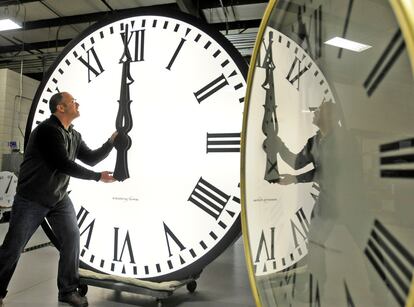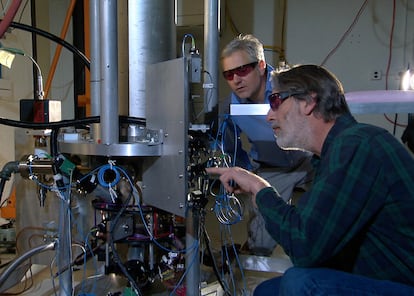One small leap: Governors of human time plan to remove extra second from calendar year
Since 1972, the additional unit has been regularly added at the end of the year to synchronize UTC with Universal Time. Now, experts are seeking an alternative solution

For centuries, if a clock moved backwards or forwards by a few minutes, nothing much came of it. A little over a decade ago, a miscoordination of a nanosecond (one billionth of a second) led scientists to believe they had discovered particles that traveled at faster than the speed of light. In today’s world, life depends on the accuracy of measuring the span of a single second. The problem is that a second on Earth is not the same as a second in space. Therefore, those who govern the passage of time have proposed doing away with the leap second that every now and then is added to reconcile human time with astronomical time, as was the case in 2015 and 2016, the last time a leap second was employed.
Scientists knew it would happen. They knew that a day does not last exactly 86,400 seconds and they knew that sooner or later, time as marked by the motion of the planet would be different from the time marked by the clocks: a day does not last exactly one day because the Earth’s rotation is not exact. René Duffard, an astronomer at the Institute of Astrophysics of Andalusia in Spain explains: “Historically, the Earth’s rotation was taken as the reference point, the standard for defining a day. The passage of the star through a meridian, for example, was measured. That meridian of reference was the Greenwich meridian.” The problem is that the time it takes for the Earth to rotate around itself is not constant. “And it is not constant because of the tidal forces of the Moon, the Sun and, above all, because the planet is not a solid object, its crust moves, it has a liquid core... and all these factors end up making the day – the time it takes the planet to rotate – inconstant. And we can measure that because we have a super-precise instrument: the atomic clock.”
Atomic clocks are incredibly meticulous. They contain a molecular pendulum in which atoms of a chemical element (cesium, ytterbium, strontium…) swing back and forth nine billion times per second. Such precision made them the absolute rulers of time in the middle of the 20th century. Today, a network of 450 atomic clocks marks Coordinated Universal Time (UTC). As astronomical time (Universal Time or UT1) becomes increasingly out of sync with UTC due to the inaccurate rotation of the Earth, every few years a leap second was added to the records of the atomic clocks. If a leap second was not added, the gap between the two ways of counting time would increase, affecting a multitude of systems. Since these leap seconds were first added in 1972, UTC and UT1 have been synchronized 27 times. Over the course of that half century, there are still another 37 seconds of accumulated delay. On New Year’s Eve, 2022, such a delay could have been reduced if 23:59:59 was followed by 23:59:60, but this is not going to be the case. Those responsible for organizing and measuring time seem determined to retire the leap second.
The International Bureau of Weights and Measures (BIPM) is the global coordinator of metrology. At the 27th General Conference on Weights and Measures (CGPM) held in Paris in November, the bureau proposed eliminating the adjustment offered by the addition of leap seconds, having previously done so in 2012 and again in 2015. This time, though, it seems the BIPM is not to be turned.
María Dolores del Campo, director of the mechanical magnitudes and engineering division of the Spanish Metrology Center, participated at the BIPM meeting. “Until now, Coordinated Universal Time – which is the international time standard used by most countries to establish their legal time – has always been adapting to astronomical time,” she explains. When the Earth’s rotation was 0.9 seconds behind UTC, it would be fixed by adding a leap second. “But global navigation satellite systems and all the digital systems we have are not prepared to make one-second jumps from time to time,” Del Campo points out. The biggest risk was posed by the universality of time coming to an end. “Private companies were starting to create their own time patterns or time scales,” Del Campo says. Some were adding the extra second in the final minute of December 31. Some added it to the first second of the New Year, while others added the leap second, by spreading it over the 86,400 seconds of the last day of the year.

“There was a danger that if you didn’t know what scale the other person was using, there would be an inconsistency in time measurements,” Del Campo says. This is particularly sensitive in the case of financial transactions or stock market operations that carry a time stamp, a mark that can be measured in nanoseconds and that, in the case of stock market prices, is essential to establish the value of a transaction. “If all those transactions are not carried out with a timescale that is consistent and unique, chaos would ensue” As such, the BIPM has decided to stop introducing the leap second between now and 2035. “Until then, we will study and consult on what to do in the future: whether we are going to wait until we have a difference of maybe a minute or a week, or not make a correction again until 100 years from now,” says Del Campo.
Causing even greater uncertainty is the movement of the planet itself. Generally, the Earth rotates ever more slowly on itself, but there are times when it speeds up. “That means that instead of introducing a positive second, we would have to introduce a negative second! How could something like that affect digital systems, the control of satellites, financial transactions? The problem is that you can’t predict how the Earth is going to rotate, either now or in 100 years,” says Del Campo.
Captain Héctor Esteban Pinillos is the head of the Time Department at the Royal Institute and Observatory of the Spanish Navy, which sets the official time in Spain. In his opinion, adding a negative second would provoke “unforeseeable consequences.” Until now, the introduction of the leap second was carried out via software, which added it to four of the cesium clocks operated by the observatory while leaving a fifth clock unmodified to act as a control mechanism. Pinillos shares Del Campo’s belief that there is a risk of breaking the unity of time by adding a negative leap second. “The GPS and Galileo satellite systems ignored the leap second - they wanted continuum time. Only GLONASS [the Russian-operated satellite network] implemented it,” the captain notes. “More and more companies were using their own timescale. The unit of Coordinated Universal Time was being lost.”
The BIPM will make its final decision next spring at a special session of the GCPM in Paris. Should the leap second be consigned to history, UTC will drift away from astronomical time by as much as one minute over the course of the next century.
Sign up for our weekly newsletter to get more English-language news coverage from EL PAÍS USA Edition
Tu suscripción se está usando en otro dispositivo
¿Quieres añadir otro usuario a tu suscripción?
Si continúas leyendo en este dispositivo, no se podrá leer en el otro.
FlechaTu suscripción se está usando en otro dispositivo y solo puedes acceder a EL PAÍS desde un dispositivo a la vez.
Si quieres compartir tu cuenta, cambia tu suscripción a la modalidad Premium, así podrás añadir otro usuario. Cada uno accederá con su propia cuenta de email, lo que os permitirá personalizar vuestra experiencia en EL PAÍS.
¿Tienes una suscripción de empresa? Accede aquí para contratar más cuentas.
En el caso de no saber quién está usando tu cuenta, te recomendamos cambiar tu contraseña aquí.
Si decides continuar compartiendo tu cuenta, este mensaje se mostrará en tu dispositivo y en el de la otra persona que está usando tu cuenta de forma indefinida, afectando a tu experiencia de lectura. Puedes consultar aquí los términos y condiciones de la suscripción digital.
More information
Últimas noticias
A floating school teaches children how to save Lake Atitlán
Pablo Escobar’s hippos: A serious environmental problem, 40 years on
From Andorra to Gibraltar, a black market for Ozempic exploits its success: ‘They’re the most sought-after products in the world’
The brief rise and retreat of Generation Z in Mexico
Most viewed
- Why we lost the habit of sleeping in two segments and how that changed our sense of time
- Charles Dubouloz, mountaineering star, retires at 36 with a farewell tour inspired by Walter Bonatti
- Venezuela faces its most tense Christmas yet
- CBS in crisis after pulling a report on Trump’s deportations to El Salvador (which later leaked online)
- Bukele clan fumes over investigation exposing their new wealth










































